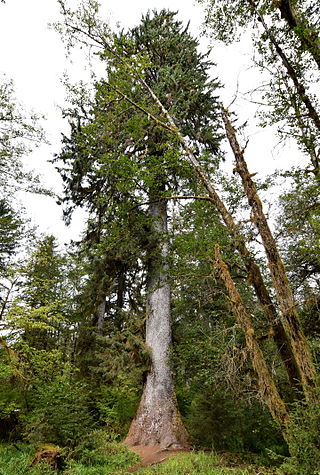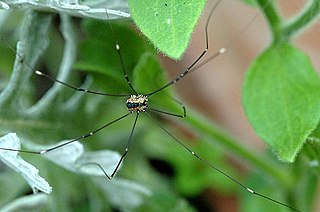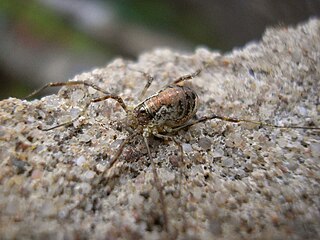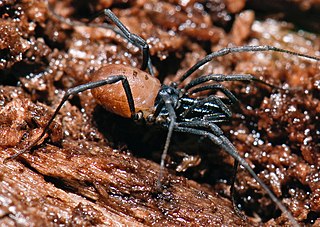
The Opiliones are an order of arachnids colloquially known as harvestmen, harvesters, harvest spiders, or daddy longlegs. As of April 2017, over 6,650 species of harvestmen have been discovered worldwide, although the total number of extant species may exceed 10,000. The order Opiliones includes five suborders: Cyphophthalmi, Eupnoi, Dyspnoi, Laniatores, and Tetrophthalmi, which were named in 2014.

The Pholcidae are a family of araneomorph spiders. The family contains more than 1,800 individual species of pholcids, including those commonly known as cellar spider, daddy long-legs spider, carpenter spider, daddy long-legger, vibrating spider, gyrating spider, long daddy, and skull spider. The family, first described by Carl Ludwig Koch in 1850, is divided into 94 genera.

Thuja plicata is a large evergreen coniferous tree in the family Cupressaceae, native to the Pacific Northwest of North America. Its common name is western redcedar in the U.S. or western red cedar in the UK, and it is also called pacific red cedar, giant arborvitae, western arborvitae, just cedar, giant cedar, or shinglewood. It is not a true cedar of the genus Cedrus. T. plicata is the largest species in the genus Thuja, growing up to 70 metres (230 ft) tall and 7 m (23 ft) in diameter. It mostly grows in areas that experience a mild climate with plentiful rainfall, although it is sometimes present in drier areas on sites where water is available year-round, such as wet valley bottoms and mountain streamsides. The species is shade-tolerant and able to establish in forest understories and is thus considered a climax species. It is a very long-lived tree, with some specimens reaching ages of well over 1,000 years.

Picea sitchensis, the Sitka spruce, is a large, coniferous, evergreen tree growing to almost 100 meters (330 ft) tall, with a trunk diameter at breast height that can exceed 5 m (16 ft). It is by far the largest species of spruce and the fifth-largest conifer in the world, and the third-tallest conifer species. The Sitka spruce is one of the few species documented to exceed 90 m (300 ft) in height. Its name is derived from the community of Sitka in southeast Alaska, where it is prevalent. Its range hugs the western coast of Canada and the US, continuing south into northernmost California.

John Blackwall was an English naturalist with a particular interest in spiders.

Araniella cucurbitina, sometimes called the "cucumber green spider", is a spider of the family Araneidae. Araniella cucurbitina is found across Europe, Western Asia, Central Asia and Japan. The cucurbitina in the name comes from the word cucurbit which is a family of plants including cucumbers.

Dicranopalpus ramosus is a species of harvestman. Males are up to 4 mm long, females can reach up to 6 mm. Both sexes have very long legs, with a distinct elongated apophysis that reaches almost to the end of the tibia. This makes their pedipalps look forked. Their body is brownish with dark markings, the females being lighter colored.

Cyphophthalmi is a suborder of harvestmen, colloquially known as mite harvestmen. Cyphophthalmi comprises 36 genera, and more than two hundred described species. The six families are currently grouped into three infraorders: the Boreophthalmi, Scopulophthalmi, and Sternophthalmi.

Mitopus morio is a species of harvestman arachnid belonging to the family Phalangiidae.

Leiobunum is a genus of the harvestman family Sclerosomatidae with more than 100 described species. Contrary to popular belief, they are not spiders, although they share a resemblance. They are arachnids, in the order Opiliones, harvestmen. Species in Leiobunum tend to have relatively long legs compared with other harvestmen, and some species are gregarious.

Leiobunum rotundum is a species of harvestman that is found within the western portion of the Old World.

Paroligolophus agrestis is a species of harvestman. It occurs in Europe, including the United Kingdom, and has been introduced to North America in the Pacific Northwest and Nova Scotia.

Phalangium opilio is a species of harvestman belonging to the family Phalangiidae.

Opiliones are an order of arachnids and share many common characteristics with other arachnids. However, several differences separate harvestmen from other arachnid orders such as spiders. The bodies of opiliones are divided into two tagmata : the abdomen (opisthosoma) and the cephalothorax (prosoma). Unlike spiders, the juncture between the abdomen and cephalothorax is often poorly defined. Harvestmen have chelicerae, pedipalps and four pairs of legs. Harvestmen were traditionally thought to have two eyes, except in the case of eyeless species. Developmental genetic work has shown that living species retain up to six eyes, including one pair of rudimentary median eyes and one pair of rudimentary lateral eyes.

Taracus is a genus of harvestman, or Opiliones, typically found living in limestone and lava caves in the United States. They grow to a size of 2.0–5.5 mm (0.08–0.22 in).
Paroligolophus meadii is a species of harvestman. It occurs in England. It is less common and significantly smaller than the related species Paroligolophus agrestis.

Scotophaeus blackwalli, also known as the mouse spider, is a species of spider belonging to the family Gnaphosidae.

Trogulus tricarinatus is a species of harvestman. It is found in Europe and North America.

Dictyna arundinacea is a species of spider belonging to the family Dictynidae. It has a holarctic distribution; It is found throughout Britain and northern Europe.















